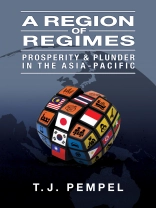A Region of Regimes traces the relationship between politics and economics—power and prosperity—in the Asia-Pacific in the decades since the Second World War. This book complicates familiar and incomplete narratives of the ‘Asian economic miracle’ to show radically different paths leading to high growth for many but abject failure for some. T. J. Pempel analyzes policies and data from ten East Asian countries, categorizing them into three distinct regime types, each historically contingent and the product of specific configurations of domestic institutions, socio-economic resources, and external support.
Pempel identifies Japan, Korea, and Taiwan as developmental regimes, showing how each then diverged due to domestic and international forces. North Korea, Myanmar, and the Philippines (under Marcos) comprise ‘rapacious regimes’ in this analysis, while Malaysia, Indonesia, and Thailand form ‘ersatz developmental regimes.’ Uniquely, China emerges as an evolving hybrid of all three regime types. A Region of Regimes concludes by showing how the shifting interactions of these regimes have profoundly shaped the Asia-Pacific region and the globe across the postwar era.
Tabla de materias
Introduction
PART ONE
1. Developmental Regimes: Japan, South Korea, and Taiwan
2. Ersatz Developmental Regimes: Malaysia, Indonesia, and Thailand: Malaysia, Indonesia, and Thailand
3. Rapacious Regimes: Plunder over Prosperity: Philippines North Korea, Myanmar
PART TWO
4. Developmental Regimes Reconstructed
5. China: Composite Regime?
Conclusion: Regimes and the Regional Order
Sobre el autor
T. J. Pempel is the Jack M. Forcey Professor of Political Science at the University of California, Berkeley, and the author or editor of twenty-four books, including Regime Shift and Two Crises, Different Outcomes.












